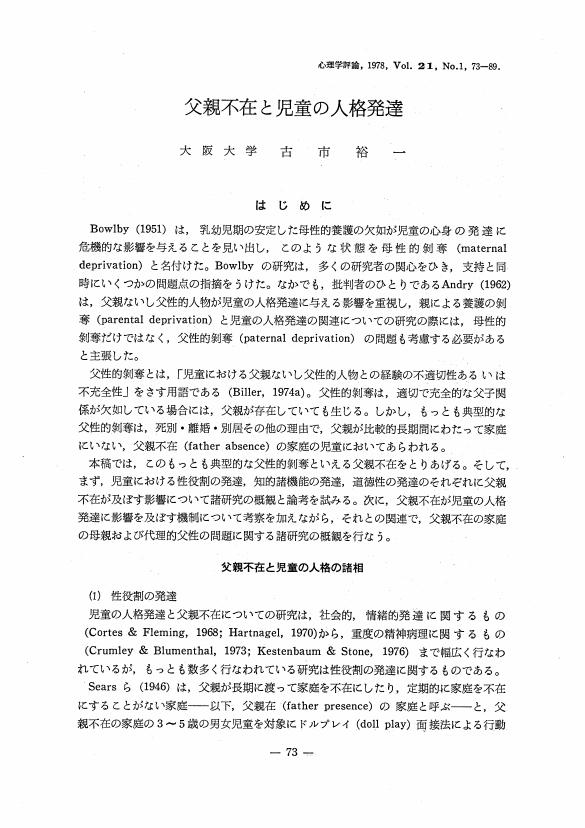2 0 0 0 OA 父親不在と児童の人格発達
- 著者
- 古市 裕一
- 出版者
- 心理学評論刊行会
- 雑誌
- 心理学評論 (ISSN:03861058)
- 巻号頁・発行日
- vol.21, no.1, pp.73-89, 1978 (Released:2019-08-07)
1 0 0 0 OA 大学生の大学進学動機と価値意識
- 著者
- 古市 裕一
- 出版者
- 日本キャリア教育学会
- 雑誌
- 進路指導研究 (ISSN:13433768)
- 巻号頁・発行日
- vol.14, pp.1-7, 1993-11-01 (Released:2017-09-22)
- 被引用文献数
- 1
The present study aimed at investigating student's motives for entrance into university and value orientation. Two kinds of inventories were administered to a sample of 1,103 undergraduates : 260 from Faculty of Education (E), 210 from Faculty of Letters (L), 206 from Faculties of Law and Economics (L-E), 224 from Faculties of Sciences, Engineering and Agriculture (S-E-A), and 203 from Faculties of Medicine, Dentistry and Pharmacy(M-D-P). One of the inventories was constructed for assessing the motives and the other for value orientation. Factor analysis was applied to the correlation matrix of the motive items and four factors were extracted: No Purpose-Compliance, Enjoyment, Pursuit of Knowledge, and Licence-Employment. Two-way of analyses of variance, with each scale score for the motive factors extracted above as dependent variable and faculty and sex as factors, yielded the following results : (1) The male students of L-E, S-E-A, and M-D-P scored higher on the No Purpose-Compliance scale than those of L and E. On the other hand, the female students of L and E scored higher than those of S-E-A. (2) The students of M-D-P and S-E-A had a stronger motive to pursue Knowledge than those of L-E, E, and L. (3) The students of M-D-P and E had a stronger motive for Licence-Employment than those of L, L-E, and S-E-A. Hayashi's Quantification Method of the 3rd Type was applied to the value orientation items. Based on the result, all the subjects were classified into four types : Egocentric, Indifferent, Heteronomous, and Serious. The relationships of the four motive factors to the four types of value orientation were as follows : (1) The students of Indifferent type scored highest on the No Purpose-Compliance scale. (2) The students of Serious and Heteronomous types had a stronger motive to pursue Knowledge than those of Indifferent and Egocentric types. (3) The students of Egocentric type had the weakest motive for Licence-Employment.
1 0 0 0 OA 大学生の大学進学動機と価値意識
- 著者
- 古市 裕一
- 出版者
- 日本キャリア教育学会
- 雑誌
- 進路指導研究 : 日本進路指導学会研究紀要 : bulletin of the Japanese Society for Study of Career Guidance (ISSN:13433768)
- 巻号頁・発行日
- no.14, pp.1-7, 1993-11-01
The present study aimed at investigating student's motives for entrance into university and value orientation. Two kinds of inventories were administered to a sample of 1,103 undergraduates : 260 from Faculty of Education (E), 210 from Faculty of Letters (L), 206 from Faculties of Law and Economics (L-E), 224 from Faculties of Sciences, Engineering and Agriculture (S-E-A), and 203 from Faculties of Medicine, Dentistry and Pharmacy(M-D-P). One of the inventories was constructed for assessing the motives and the other for value orientation. Factor analysis was applied to the correlation matrix of the motive items and four factors were extracted: No Purpose-Compliance, Enjoyment, Pursuit of Knowledge, and Licence-Employment. Two-way of analyses of variance, with each scale score for the motive factors extracted above as dependent variable and faculty and sex as factors, yielded the following results : (1) The male students of L-E, S-E-A, and M-D-P scored higher on the No Purpose-Compliance scale than those of L and E. On the other hand, the female students of L and E scored higher than those of S-E-A. (2) The students of M-D-P and S-E-A had a stronger motive to pursue Knowledge than those of L-E, E, and L. (3) The students of M-D-P and E had a stronger motive for Licence-Employment than those of L, L-E, and S-E-A. Hayashi's Quantification Method of the 3rd Type was applied to the value orientation items. Based on the result, all the subjects were classified into four types : Egocentric, Indifferent, Heteronomous, and Serious. The relationships of the four motive factors to the four types of value orientation were as follows : (1) The students of Indifferent type scored highest on the No Purpose-Compliance scale. (2) The students of Serious and Heteronomous types had a stronger motive to pursue Knowledge than those of Indifferent and Egocentric types. (3) The students of Egocentric type had the weakest motive for Licence-Employment.

